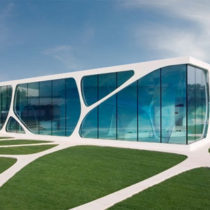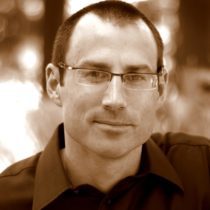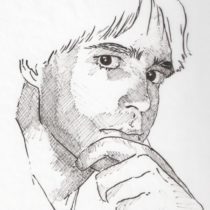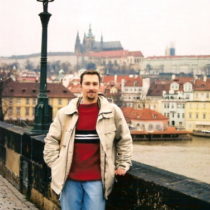Landscape Architecture for Landscape Architects › Forums › GENERAL DISCUSSION › Where do you find Inspiration
- This topic has 1 reply, 8 voices, and was last updated 14 years, 4 months ago by
 Chad Crutcher.
Chad Crutcher.
-
AuthorPosts
-
March 16, 2010 at 11:23 pm #170474
 Zach WatsonParticipant
Zach WatsonParticipantIn watching presentations on TED today I got to thinking about it, I hear about the different things that inspire Architects along with other design disciplines, and I was wondering what inspires you in the projects that you create and design.
March 17, 2010 at 2:08 pm #170484 Chad CrutcherParticipant
Chad CrutcherParticipantZach,
I have been monitoring this thread to see if/when somebody would post a response. I suggest the dearth of activity is because the question is not really phrased correctly…at least, in my opinion. You see, the point is not what is used for inspiration, it is how inspiration is attained. Your question presupposes there can be a single concept (or inspiration as you call it) that can be applied to any design problem. Now one could say I use nature as inspiration, but what does that mean? Does that mean if one is inspired by boreal rain forests it would be OK to impose that inspiration on a Sonoran Desert site?
I believe strongly in the design process. I trust it to reveal inspiration. I hope I am not inspired until I have buried myself in the problem, including visiting the site, if at all possible. Who can know ahead of time from where or what inspiration might germinate. It could be something as simple as a sound or smell or taste on-site, the color of the soil and rock…who knows until one gets there. It can even be the jurisdictional context, for all I know. The how is to be open and receptive, to let inspiration reveal itself to you.
I am interested in your answer to your own question, or perhaps more importantly, what compelled you to ask it in the first place. I am not aware of what the reference to ‘TED” is nor the presentation subject material. It would be helpful to hear a bit about this stuff. I’d like the insight behind your question.
Thanks.
Do well doing good.March 17, 2010 at 3:33 pm #170483 Ryan SandParticipant
Ryan SandParticipantTED lecture: From my memory, the TED presentations are great insightful speeches, by some of the up and coming minds of today. The TED lectures were an invite only series of some of the top minds of today. I believe you can do a basic search online and at least get a portion of it.
Concerning inspiration; the design process is a fantastic way to (for lack of a better word) process the information we collect. As Chad mentioned such information can be the site, attributes of it, even the location. While the list of inspiration is undefinable and longer than we could imagine, Zach may have presented an opportunity to accumulate and exchange ideas. If we had the chance to explore and share our inspiration, at least one person may have the chance to redefine inspiration, redefine what can drive a design, and potentially even change their design process.
Note: I personally believe one shouldn’t just take a random inspiration and plug it in, design requires a well addressed site combined with a thought out concept/design.
My favorite inspiration comes from the interaction of systems. Whether they are human psychological reactions to a space (the reaction to compression and release in bookshelves) or the swagger of a suspension bridge and its effect on the human perspective ( http://www.wix.com/rtsand/designincite -> Design -> Morgan Library or E L Center).
While we cannot list all the inspiration in the world I think it great to note those that capture our eye and drive our mind.
Ryan
March 17, 2010 at 4:04 pm #170482 Zach WatsonParticipant
Zach WatsonParticipantAs Ryan said TED is a series of Lectures that are very inspiring, they can be found at TED.com. To clarify my question, I guess I’m looking for understanding into how others work through the design process and gather/find their inspiration. I’m in my second year of my LA program and while it has been a great experience so far, I want to reach for and achieve better things in my education. I know that the achievement that I’m looking for, some of it will simply come with time and going through the design process over and over again, but I’m also interested to understand how other people work through the design process.
In many ways I would love to see, in case studies or on websites, the design process that an LA worked through to get to the final design, I have seen some firms show this process on their website, but many just talk about the project and show renderings/pictures of it. I guess more than anything else I would love to see how others in the field, work and how they come to conclusions in their design.
I hope this is a little more clear as to what my question is.
Zach
March 17, 2010 at 4:45 pm #170481 ncaParticipant
ncaParticipantTheres no formula or science to it in my experience Zach.
If you havent already, check out Frank Ghery’s film by Sidney Pollack ‘Sketches of Frank Ghery.’ Pollack, a great directir, and Ghery, a great architect talk at one point in the film about the process of ‘becoming’ what you do. Pollack talks about ‘pretending’ to be a director until waking up one morning to dicover that he had become a real director. In essence, ‘fake it til you make it.’ …I guess. You see lots of first and second year design students doing this-running out after studio to buy some thick-rimmed glasses- it helps, we’re visual creatures.
Ghery talks about his process in starting a new project. I laugh every time I’ve watched the scene- He talks about making excuses, cleaning his desk, running errands, and generally doing anything he can to avoid ‘the problem.’ As inexperienced and naive as I may be, I find myself doing the same things when given a new project, whether now at work or in the school studio.
I think the difference between the process you go through at school versus work is that you gotta have something by the end of the day…else you may not get much again, especially when just starting out as a designer. In other words, it pays to keep scratching on paper or tinkering with a model while you waste time and daydream.
I’ve found that it also helps to pick an idea, when some inspiration comes (whther the idea itself is inspired or not) and run it all the way through, ie make some renderings, a nice plan, a model, and then let it age for a day or two and come back to it. I find that its easier to respond to a nice colored plan or graphic than it is to stay living in the abstract. At some point you have to pull the trigger and react.
Ultimately, I think a lot of design is as simple as making ‘something to point at,’ though that may be the lowest common denominator of design process.
Hope that hlps, everyone is different I’d summise.
March 17, 2010 at 5:11 pm #170480 Trace OneParticipant
Trace OneParticipantMany thoughts on my own design process, but I just wanted to point out that it is currently fashionable among architects to take their inspiration from cells, microbes, bubbles, things like that, and to pretend the building is living, the exterior can function like a real skin of a living thing..
Personally think architects are still ignoring the human scale, as they ever have, the streetscape, with this new fashion..but there ya have it..
Gehry, I have heard, takes crumpled napkins for inspiration.
Frank Lloyd Wright of course the plains of the prairie, for his building lines..
In school we did Ellis Island, and everyone became obsessed with this particular type of window they had, and used it in their designs..I agree with Nick, it comes from many things – part of the fun – and I agree with the other poster, we are uniquely responsible to fist discover the facts on the ground, the McHarg layercake, and to be responsible to human behavior, and to go from there..And I am big on history – you must know history, so you know that the curved oval pond with brick paths in a depression you have just designed may remind people of Beatrix Farrand..etc…By studying history we can see designs that have achieved unity, as opposed to your run-of -the mill stuff..Unity is the goal..so every element of the design fits, both the site and the concept..
takes a lot of work!
March 17, 2010 at 11:46 pm #170479 Chad CrutcherParticipant
Chad CrutcherParticipantAn inspiring discussion, indeed. Thanks to those that explained TED.com. I shall avail myself of its benefits.
My next contribution is two words: Universal Traveler $14.95 at Amazon.com
Zach, if you have not heard of this book, or, if you have and not purchased it yet, then please do so. Upon reading it and using it, I believe you will quickly learn what Nick said…it is a zen-like experience. You will find the answers to your questions in this text…and it is a textbook, on the design process. It was written by 2 instructors at the School of Architecture and Environmental Design @ Cal Poly, SLO and first published during my second year there in 1975.
Trace, I agree if you are suggesting Gehry’s napkin concept is folly. Yes, his first exploration of the idea at Bilboa was great and new, but now everybody wants a copy. With no disparaging feelings toward those that better appreciate his work, I enjoy his works done during periods of new experimentation and discovery. To many copies came afterward each time and it got stale.
The organic concepts for architecture make a great deal of sense. Copying the success of natural systems seems perfectly compatible with sustainability. I’m waiting to see what happens when they catch up to the botanists and other life sciences now looking at and understanding biological systems as information exchange systems like digital data and computers…imagine buildings that sense everything and are in constant adaptation, almost, if not actually biologically linked to its occupants!
In the end, no matter what, it is all about the experience.
March 18, 2010 at 12:11 am #170478 Chris HeilerParticipant
Chris HeilerParticipantI love TED…very inspiring and interesting stuff.
Here’s a link to check it out:
http://www.ted.com (you probably could have figured that out :-))
March 18, 2010 at 12:35 am #170477 Jon QuackenbushParticipant
Jon QuackenbushParticipantjust purchased the book chad…
March 18, 2010 at 1:35 am #170476 BoilerplaterParticipant
BoilerplaterParticipantLook up James Howard Kunstler’s presentation to TED. He talks about the inspiration of the architects for a particular bland building. Its good for a laugh.
I’m remined of a line from a song by Matt Johnson (The The). It goes “One day I asked the angels for inspiration, but the devil poured me a drink.” Its about how much inspiration gets co-opted, watered down, misdirected, what-have-you. Its about how easy it is to lose an inspired idea to other forces that compete for your attention.
But to anwer your original question, I’m inspired by music, for one thing. I always liked Goethe’s analagy of architecture as “frozen music” In landscape architecture you have an added dimension in that its NOT frozen. Plants grow, things change with the seasons. Natural forces are another big inspiration. I saw the noted LA A.E. Bye speak some years ago, and he talked about being inspired by malevolence in nature, like how strong winds had acted on the growth of a tree, and the destructive power of waves. He thought LAs we too into nature as a warm, nurturing kind of force, and that other aspects of nature should influence design as well. I just thought it was an interesting idea.
March 18, 2010 at 7:24 pm #170475 Ryan SandParticipant
Ryan SandParticipantOn to what Nick said,
Personally, there should always be evidence at the end of the day that you processed something, whether in school or in the working world. An old teacher of ours encouraged just going and drawing, showing something on a piece of paper is something more than just prolonged research or “meditating”. I personally use collage in the terms of analysis as well because the imposition of textures adds vision as well as a more tactile way to react.
This part of the process is important for me for several reasons;
a) you get on to a new idea by mentally placing one thought on the paper and clearing the head for new ideas or the next evolution
b) it is easier to share and discuss an idea with others when its on paper
c) the drawing provides numerous ways for a thought to evolve (hey this form is similar to a _______, hey this area provokes a similar experience to _____) .
Some say there is no original ideas this day, well I can always argue there are at least new takes on old ideas.
In reflection to the architect inspiration, Gaudi from barcelona was notorious and fantastic for using nature and human habits for design inspiration.
-
AuthorPosts
- You must be logged in to reply to this topic.

